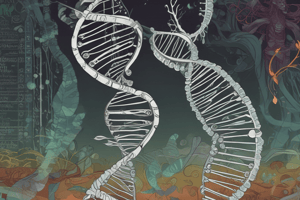Podcast
Questions and Answers
What is the change of one base to another in a DNA sequence called?
What is the change of one base to another in a DNA sequence called?
substitution
What is a change in one or a few nucleotides that occurs at a single point in the DNA sequence called?
What is a change in one or a few nucleotides that occurs at a single point in the DNA sequence called?
point mutation
What is it called when part of one chromosome breaks off and attaches to another?
What is it called when part of one chromosome breaks off and attaches to another?
translocation
What is a heritable change in genetic information known as?
What is a heritable change in genetic information known as?
What is a mutation that produces an extra copy of all or part of a chromosome called?
What is a mutation that produces an extra copy of all or part of a chromosome called?
What do you call a chromosomal mutation that reverses the direction of parts of a chromosome?
What do you call a chromosomal mutation that reverses the direction of parts of a chromosome?
What is a kind of mutation that can change every amino acid that follows the point of mutation?
What is a kind of mutation that can change every amino acid that follows the point of mutation?
What is the addition of a base to the DNA sequence called?
What is the addition of a base to the DNA sequence called?
What happens when cells cannot repair the damage caused by a mutagen?
What happens when cells cannot repair the damage caused by a mutagen?
What is a possible mutagen?
What is a possible mutagen?
Which of the following most accurately summarizes the effects of mutations on living things?
Which of the following most accurately summarizes the effects of mutations on living things?
Why are mutations important to the evolution of a species?
Why are mutations important to the evolution of a species?
Cancer is the product of a mutation that causes what?
Cancer is the product of a mutation that causes what?
What is polyploidy?
What is polyploidy?
Explain how a change in a single base in DNA can bring about such a serious disorder as sickle cell disease.
Explain how a change in a single base in DNA can bring about such a serious disorder as sickle cell disease.
Flashcards are hidden until you start studying
Study Notes
Mutations Overview
- Substitution: A change of one base to another in a DNA sequence.
- Point Mutation: A change occurring at a single point in the DNA sequence, affecting one or a few nucleotides.
Types of Mutations
- Translocation: Occurs when part of one chromosome breaks off and attaches to another chromosome.
- Mutation: A heritable change in genetic information that can occur through various mechanisms.
- Duplication: A mutation resulting in an extra copy of all or part of a chromosome.
- Inversion: A chromosomal mutation that reverses the direction of parts of a chromosome.
- Frameshift Mutation: A mutation that alters every amino acid following the point of mutation, typically caused by insertions or deletions.
- Insertion: The addition of a base to the DNA sequence, resulting in a potential frameshift.
- Deletion: Can occur as a gene mutation (removing a base from the DNA) or a chromosomal mutation (losing part/all of a chromosome).
Mutation Rates and Effects
- DNA replication machinery inserts an incorrect base roughly once in every 10 million bases.
- Small genetic changes accumulate over time, influencing evolution.
- Mutagens, such as ultraviolet light, can cause changes in DNA sequences.
- If cells cannot repair mutagen-induced damage, the DNA base sequence changes permanently.
Impact of Mutations
- Most mutations have little to no effect, while some can be harmful or beneficial, impacting fitness.
- Mutations are a source of genetic variability, crucial for the evolution of species.
- Cancer results from mutations that enable uncontrolled cell growth.
- Polyploidy: Condition where an organism has an extra set of chromosomes, often observed in plants.
Specific Case: Sickle Cell Disease
- Sickle cell disease is caused by a substitution mutation in the hemoglobin gene located on chromosome 11.
- A single base-pair change leads to the incorrect incorporation of valine instead of glutamic acid in hemoglobin.
- This alteration affects the protein's structure and function, resulting in serious health consequences like sickle-shaped blood cells.
Additional Notes
- Ensure to review handouts for detailed visual information on blood cell differences and specific mutation processes.
Studying That Suits You
Use AI to generate personalized quizzes and flashcards to suit your learning preferences.



